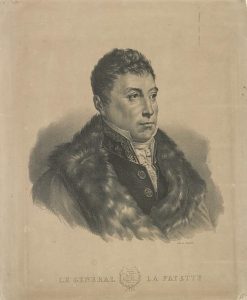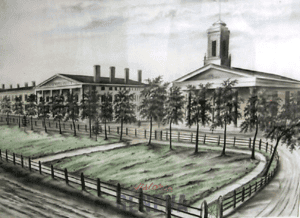General Lafayette’s Visit to Geneva, 1825
In 1824, President James Monroe and Congress invited General Lafayette to visit the United States as part of the festivities marking the 50th Anniversary of the Declaration of Independence. Between August 1824 and September 1825, Lafayette (with his son, a secretary and two friends), visited all 24 states. It was a fast-paced tour with frequent, unscheduled stops – Geneva being one of them.
To celebrate the 200th anniversary of Lafayette’s visit there will be a re-enactment on Sunday, June 8, from 10 a.m. to 12 p.m. at Pulteney Park. For more information click here.
Here is an account of Lafayette’s visit from the Geneva Gazette, June 15, 1825
A committee had been appointed to invite General Lafayette to Geneva and to make suitable arrangements to receive and entertain him. This committee was as follows: James Rees, Samuel Colt, Henry Dwight, Joseph Fellows, William Tillman, committee of Citizens; George Goundry, William S. DeZeng, Richard M. Bayly, John Sweeney, Phineas Prouty, trustees of the village.
On the 28th of May the Committee transmitted a letter to Buffalo containing the invitation but being aware of the celerity of his movements two of their number were deputied to meet the General on his arrival at Rochester and deliver him a duplicate of this letter. This sub-committee were enabled to satisfactorily accomplish their mission, and on the morning of the 7th of June an express arrived and brought information that the General had accepted the invitation and would be in Geneva on the morning of the next day.
The Committee made all the arrangements which the shortness of time allowed so that he might be received in a suitable manner. Information was at once sent by express to the neighboring towns and the response was prompt and spontaneous. The county court of Yates County immediately adjourned to give opportunity to the citizens of that county to unite in the ceremonies and on the morning of the 8th of June the people were flocking to Geneva from all quarters.
General Lafayette arrived at Canandaigua on the evening of the 7th of June and at about 7 o’clock on the morning of the 8th he left that place and proceeded on his way to Geneva. At Ball’s Tavern on the old turnpike, seven or eight miles west of Geneva, he was met by a committee from Geneva who had carriages in waiting to receive him and suite, consisting of his son Mr. George Washington Lafayette, his secretary Mr. LaVasseur, and his friends Mr. Cumes and Mr. Slon. An elegant open carriage was furnished by W.S. DeZeng for the use of the General, which was drawn by six gray horses.
Having been received by the members of the Committee from a Committee who attended him from Canandaigua, they proceed with him and his suite to the village, and were escorted by Capt. Sherman’s company of calvary from Yates County and followed by a body of citizens on horseback.
As soon as the carriage came in sight of the village a signal gun was fired, and the military escort was increased by [companies of calvary, artillery, and light infantry], together with many officers and neighboring regiments in uniform, and a great body of citizens, when the whole took up the line of march conducted by Capt. Bayly as Marshal of the day, assisted by Capt. Dox, Lieut. Stanley, and Mr. Butler. The private citizens, all being uncovered, formed two lines through which the carriages passed to a stage erected on the Public Square [Pulteney Park] in front of which was the platform. In front of the platform and to the rear of the stage were erected columns supporting arches tastefully adorned with wreaths and flowers. On the sides of the front arch were the following inscriptions
WELCOME LAFAYETTE
WASHINGTON AND LAFAYETTE
The platform and stage were carpeted and sofas placed for the General, his suite and the committee. All the arrangements in the square had been made under the direction of Messrs Misner and Schermerhorn.
From the stage was presented a beautiful view of the lake. On the side of the platform a number of young ladies were stationed who strewed flowers as the General passed to the stage and they greeted him by singing an Ode composed for the occasion by a young lady in the fourteenth year of her age, a daughter of Dr. Lummis. The following is a copy
Welcome Patriot to the shore
Where none but Freeman tread –
Welcome to the Land once more
Where freedom’s warriors bled;
Columbia’s Sons shall ne’er forget
The brave, illustrious Lafayette
When wrapped in war’s terrific gloom
Incompassed round with foes,
You left your country and your home,
To bleed for foreign woes;
Columbia’s Sons will ne’er forget
Their benefactor, Lafayette.
To the rear of the young ladies sat a large number of ladies and gentleman and a venerable body of soldiers of the Revolution, distinguished by badges. All the windows of the houses on the Square were crowded with ladies who welcomed the General by waving their handkerchiefs.
After the General and his suite had been introduced by Major Rees to those on the stand, an address of welcome was delivered by Col Bowen Whiting to which the General appropriately responded, explaining his satisfaction at the kindness with which he was received by his fellow citizens in the United States, the pleasure to be derived from their approbation of his public conduct and his ardent wishes for the continued happiness and prosperity of our country.
After the ceremonies in the Square were over, the General was escorted to the Franklin House, where an elegant breakfast was prepared by Mr. Noyes. Two hundred citizens partook of it with the General and his suite.
Before breakfast a very affecting and interesting interview was had between the General and the veterans of the Revolution, many of whom served under him and others knew him during the war. The age and venerable appearance of these old soldiers excited the most tender sympathies and all who witnessed the interview were deeply affected by it.
At one o’clock pm General Lafayette left amidst the acclamations of the citizens and was escorted to Waterloo by Capt Ruggles’ Troop of Calvary, and a number of citizens on horseback and in carriages.
This article was brought to you in part by our supporters. Be our partner in telling Geneva’s stories by becoming a Historic Geneva supporter.


